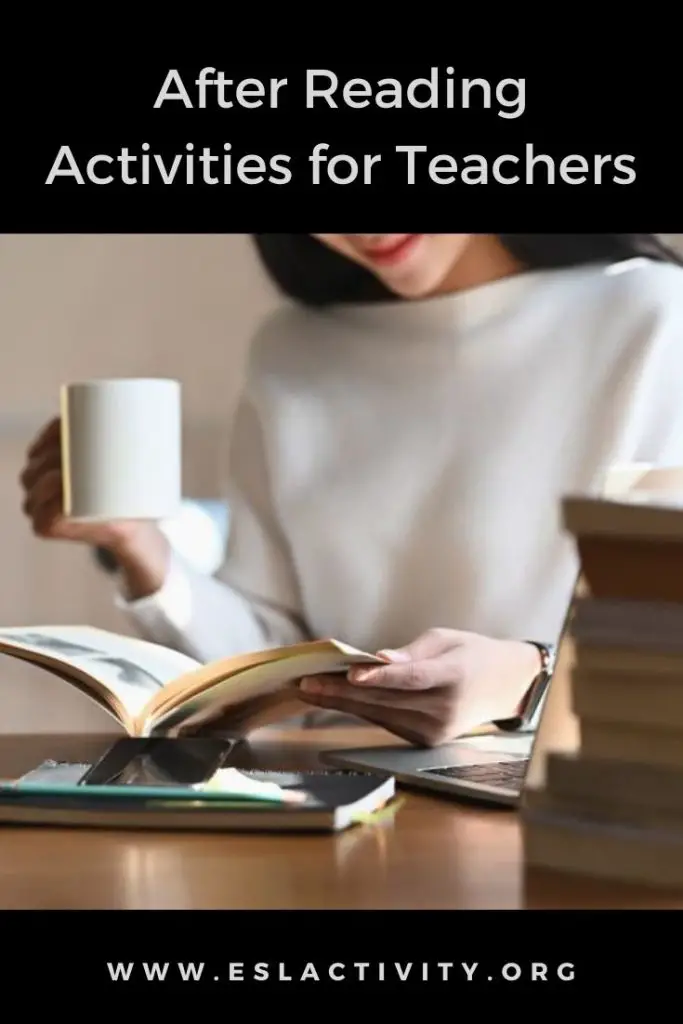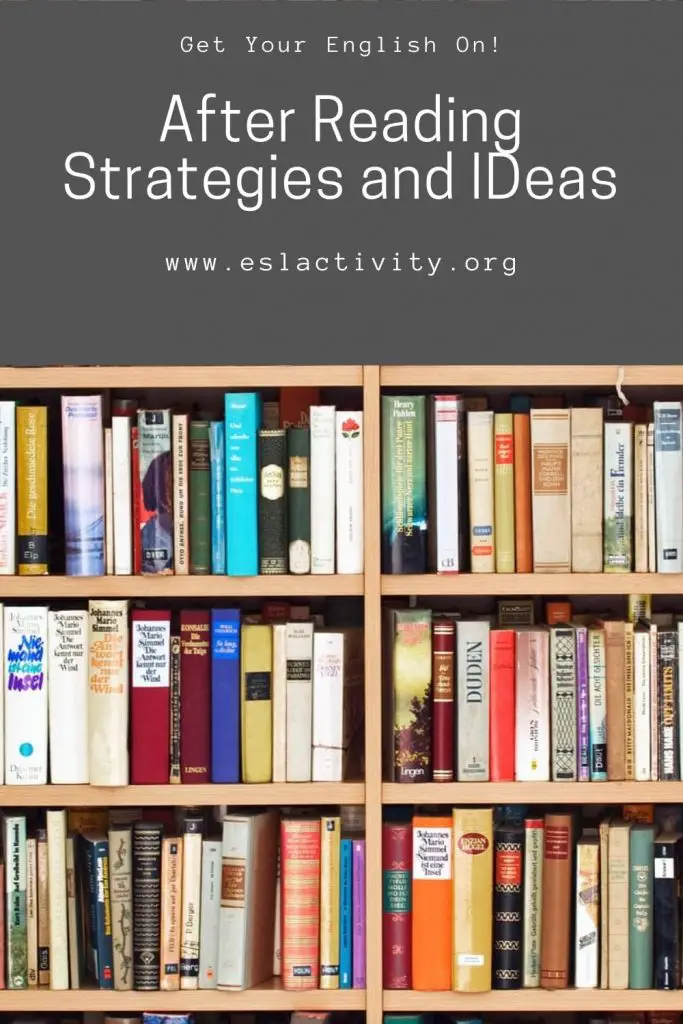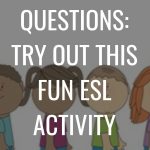If you’re looking for some post reading activities and ideas for English lessons, then you’re in the right place. We have lots of after-reading activities and strategies for fiction and non-fiction for all ages and levels of students. Keep on reading!

Postreading activities and ideas
What is Post Reading?
Post reading is what readers do after reading something. They are activities that help readers summarize, reflect or question what they’ve just read. Activities done after reading also help to build reading comprehension skills as well as increase vocabulary range.
Post Reading Activities and Games for ESL
Let’s get into the best post-reading ideas and strategies that teachers and readers can use to improve reading skills!
#1: Look for Parts of Speech or Grammatical Constructions
In a TEFL class (or even a regular English class with native speakers), it can be a helpful exercise to have students look for certain part of speech or grammar points such as adjectives or conditionals to name just two. Each story will lend itself to some things more than others.
#2: Post Reading, Consider the Plot
A nice after-reading activity for students is to consider the plot more carefully. They can do the following:
- Make a timeline of the main events.
- Think about where the action occurs and make profiles of these places. Students can even draw a map to show how these places relate to each other.
- Choose the most pivotal point in the story and talk about why they chose that incident.
- Talk about the big choice that the main character had to make and talk about what the end of the story would have looked like if they had made a different choice.
#3: Postreading, Consider the Main Characters
A nice post reading activity after reading a fiction book is to consider the main characters more deeply. If done individually, I’ll often let students pick who they want to profile. If done in groups, I’ll usually have each group choose a different character from the book. Here are some ideas for what students can do:
- Make a fact file about each character, including their physical appearance, personality, family, etc.
- The teacher can think of a situation that isn’t in the book and students have to talk about what they think their character would do.
- Describe how the character changed throughout the story. What caused them to change?
- Consider a scene from another character’s point of view. Would their actions be different from the original version?
Need something to read with your students? Have a look here: Books for English learners.
#4: Comprehension Questions
This is a classic post-reading activity! Prepare some comprehension questions for students to answer. I like to put students into pairs or small groups and have them discuss them together. Then, we come together as a class and I choose groups to share what they talked about.
#5: Morals and Values
Stories often have some kind of lesson related to a moral or value. A fun idea is to have students survey each other with questions related to the morals learned about in the story. For example, if the lesson was about honesty, some of the questions could be:
- What would you do if you found a $100 bill on the street?
- If you saw a classmate cheating on a test, would you tell the teacher?
There are various ways that I like to use surveys with my students. Here are just a few ideas:
#6: Dictogloss
In language classes, grammatical concepts or vocabulary sets are often introduced in a reading passage. Dictogloss is a nice after-reading activity to give students some practice with what they’ve just learned.
Find, or write a passage filled with the target language. Then, it becomes a challenging listening exercise. Find out more about it here:
#7: Post-Reading Book Review
People often review books on places like Goodreads or Amazon. Students can also review the books that they read in class! Depending on the age and level of students, I’ll sometimes do this in class or I’ll have students complete the assignment for homework.
The length varies as well. Sometimes I require around a page while other times, just a few sentences will do. It can be helpful to show students some simple book reviews (from another book) so that they can check out the format.
#8: Postcard Activity for After Reading
Students can choose one of the characters from the book and pretend that they’re writing a postcard to someone from a certain point in time from the book. This is a nice after reading strategy to get students to think more deeply about the character, from their point of view.
#9: Learn More about Teaching ESL Reading
Check out this podcast for some of my favourite ESL reading games and activities.
#10: Create a Poem
A nice post reading activity is to have students make a poem about a character or event from the story. Prior to this, I teach students about a certain poetry form (haiku, acrostic, sonnet, etc.) and require students to follow that form.
#11: Look for Reading Devices
Stories contain things like foreshadowing, metaphors, similes, etc. I teach my students about these things and then have them look for examples of them. It’s a nice group activity!
For non-fiction, I have students find things like the thesis statement and topic sentences.
#12: Write a Diary Entry
This after reading activity requires that students choose a character and then an event from the story. They have to write a diary entry from that person’s point of view, talking about their feelings about what just happened.
#13: Vocabulary Auction
New grammatical concepts in a language class are often introduced through a reading passage (the other option is through listening). This is important in order to set the context and give students a chance to see the language being used in a natural way.
If that’s the purpose of your reading, then consider using this game, vocabulary auction. Students have to make grammatically correct sentences but in a very fun way. Check it out:
#14: Look up Unfamiliar Words
I usually tell my students to make a guess about what a word means if they don’t know it, based on the context of the other words around it. However, I do tell them to circle it. Afterwards, they can come back to it, look it up and then write it down in their notebooks.
#15: Creative Writing Challenge
Students can choose 10-15 interesting words from the text and then write a short story using them. Or, it could be a news report, poem, or another kind of written piece.
#16: Comprehension Quiz for Post Reading
Put students into pairs and have them make 5 comprehension questions about what they’ve read. Then, they can exchange quizzes with another group. Or, you could collect the questions and make them into a Jeopardy-style quiz session for the entire class.
#17: Change the End of the Story
A nice exercise is to have students change the ending of the story. This requires some serious critical thinking and I love to see the differences among my students—some of them come up with some very creative answers. I like to share the various ideas with my students too!

After reading strategies and activities
#18: Discussion Circles
Divide students into small groups and assign each group a specific topic or question related to the reading. Students take turns discussing their thoughts, sharing key points, and asking each other questions. Encourage active participation and provide guidance as needed.
#19: Retell or Summarize
Ask students to individually or in pairs retell or summarize the main ideas or key events from the reading. This activity helps reinforce comprehension and encourages students to identify the most important information.
#20: Creative Writing
Assign a writing task that requires students to apply the information from the reading. For example, they can write a letter to a character in the story, create a new ending, or compose a summary paragraph. This activity promotes critical thinking, creativity, and language production.
Post Reading FAQs
There are a number of common questions that people have about after-reading activities. Here are the answers to some of the most popular ones.
How can I plan an ESL reading lesson?
What is post reading activities example?
There are a number of post reading activities that you could consider using. Some of them include:
- Book review.
- Plot Summary.
- Character analysis.
- Write a poem.
- Comprehension questions.
Why are post-reading activities important?
Post-reading activities are so important because they facilitate maximum comprehension of a text. They can help the reader understand what they’ve read and organize their thoughts as well as check for understanding.
How can I teach ESL reading?
How do post reading activities benefit English learners?
Post reading activities can benefit English learners because they check for comprehension, allow for deeper understanding of a text, as well as increase control of English (grammar and vocabulary).
More Ideas for Teaching Reading
Do you want even more ideas for teaching reading to English learners? Then you’re going to love this book that you can easily find on Amazon: ESL Reading Activities for Teenagers and Adults. If you want to level up your TEFL reading classes, then you’re going to want to pick up a copy!
You can find the book in a variety of formats. Get it today and then get ready for better English classes tomorrow:
After Reading Activities: Join the Conversation
Do you have any ideas for post-reading games and activities that you’d like to share with us? Please leave a comment below and let us know what you think about it. We’d love to hear from you.

After reading strategies for English learners
Last update on 2022-07-17 / Affiliate links / Images from Amazon Product Advertising API





